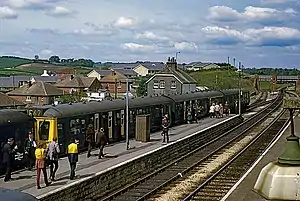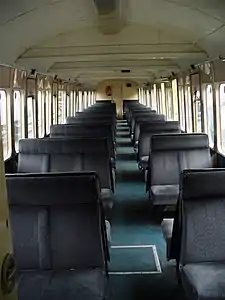British Rail Class 117
The British Rail Class 117 diesel multiple units (DMUs) were built by Pressed Steel from 1959 to 1961. It was a licence-built variant of the British Rail Class 116.[1]
| British Rail Class 117 | |
|---|---|
 117 007 at Maiden Newton, 1975 | |
 Interior of a Class 117. | |
| In service | 1959–2000; one unit used in departmental use until 2015 |
| Manufacturer | Pressed Steel Company |
| Family name | First generation |
| Replaced | Steam locomotives and carriages |
| Constructed | 1959–1961 |
| Number built | 123 cars (42 DMBS, 42 DMS, 39 TCL) |
| Number preserved | 35 cars (17 DMBS, 16 DMS, 23 TCL) |
| Number scrapped | 88 cars (25 DMBS, 26 DMS, 16 TCL) |
| Formation | DMBS-TCL-DMS |
| Operator(s) | British Rail ScotRail Silverlink |
| Line(s) served | Western Region London Midland region Scottish region |
| Specifications | |
| Car body construction | Steel |
| Car length | 64 ft 0 in (19.51 m) |
| Width | 9 ft 3 in (2.82 m) |
| Height | 12 ft 8 1⁄2 in (3.87 m) |
| Doors | Slam |
| Articulated sections | Single car (2) |
| Maximum speed | 70 mph (113 km/h) |
| Weight | Power cars: 36 long tons 0 cwt (80,600 lb or 36.6 t), Trailer cars: 30 long tons 0 cwt (67,200 lb or 30.5 t) |
| Prime mover(s) | BUT (AEC) then BUT (Leyland), of 150 hp (110 kW), (both types), two per power car |
| Power output | 600 hp (450 kW) per 3-car set |
| Transmission | Mechanical |
| Train heating | Oil burning air heater |
| Braking system(s) | Vacuum |
| Safety system(s) | AWS |
| Coupling system | Screw |
| Multiple working | ■ Blue Square |
| Track gauge | 4 ft 8 1⁄2 in (1,435 mm) |
Original work
A total of 123 Class 117's were built by Pressed Steel between 1959 and 1961. The Class 116 was ordered in large numbers which Derby Works could not fulfil, so the work was sub contracted. When first introduced in 1960, these three-car units were all based with the similar Class 121 single carriage (railcar) units on British Railways Western Region for suburban work out of London Paddington. The units were largely based at Reading and Southall depots. The units remained here for many years working these services.[2]
The type was used for a railtour from Paddington to the south west on 31 May 1969.[3]
Later operations
In the 1980s, expiry of other DMUs facilitated moves for some units from the Western Region to Birmingham, as below, and Scotland, prior to the delivery of new units to replace them. They were given refurbishments.
The first shake up in ownership occurred in the late 1980s, when the Scottish, Welsh, Cornish and Birmingham based units were transferred to Provincial Services, later Regional Railways, in the sectorisation of British Rail, while the Southall-based units transferred to Network SouthEast. The Regional Railways units were refurbished at Tyseley Locomotive Works.[4]
In the early 1990s, several units were named: 701 (51350/92) was named 'Marston Vale' and 705 (51358/400) was 'Leslie Crabbe'.[5]
They were replaced on the lines out of Paddington when the Class 165/1 'Network Turbo' units came into service by 28 November 1992.[6]
They soldiered on in the former Western Region until replaced by Class 150 and Class 153 DMUs by 21 May 1993, although the type could be found running Penzance - Looe services until 1997. An attempt was made to remove them from Cornish work using Class 142 "Skipper/Pacer" units, but these fixed wheelbase units proved to be a liability on the tight Cornish branchline curves, increasing rail and wheel wear, moving to the North of England instead. They were finally replaced with the advent of more Class 150s and Class 153s freed up from other areas.[7]
The type was used in Scotland between Edinburgh - Perth, Cowdenbeath and Markinch using the Forth Bridge and continued to work in Scotland until 12 January 1998, where they were replaced with Class 156s.[8] The final day of 117s running in Scotland was 27 November 1999.[9]
For many years, passenger services on the Birmingham Cross-City Line were worked by Class 117, along with Class 115, 116, 118 and 121 diesel multiple units, but all were withdrawn from service by 1995.
In 2000, Class 150 Sprinter units replaced the Class 117 units on Silverlink, finally bringing to an end decades of service on Britain's rail network in front line service.[10]
Once in preservation it has since been discovered that the units had all sorts of Leyland 680 engine variants.. For example, one unit was noted as having a Leyland 680/1 (150 BHP) and a Leyland 680-1595 (180 BHP) .
| Lot No. | Type | Diagram | Qty | Fleet numbers | Notes |
|---|---|---|---|---|---|
| 30546 | Driving Motor Brake Second (DMBS) | 534 | 42 | 51332–51373 | |
| 30547 | Trailer Composite with lavatory (TCL) | 601 | 39 | 59484–59522 | |
| 30548 | Driving Motor Second (DMS) | 535 | 42 | 51374–51415 | |
Gallery
 A Rail Blue and Grey liveried three car Class 117 DMU at Peterborough Nene Valley railway station on the preserved, heritage Nene Valley Railway.
A Rail Blue and Grey liveried three car Class 117 DMU at Peterborough Nene Valley railway station on the preserved, heritage Nene Valley Railway. The unpowered centre TCL vehicle from a Class 117 DMU.
The unpowered centre TCL vehicle from a Class 117 DMU. The interior of the mid 1980s refurbished First Class cabin, in Network SouthEast moquette, aboard a three car Class 117 DMU.
The interior of the mid 1980s refurbished First Class cabin, in Network SouthEast moquette, aboard a three car Class 117 DMU. The interior of the mid 1980s refurbished Standard Class accommodation, in Network SouthEast moquette, aboard a three car Class 117 DMU.
The interior of the mid 1980s refurbished Standard Class accommodation, in Network SouthEast moquette, aboard a three car Class 117 DMU.
Preservation
Due to the type's longevity, 12 units have been preserved on heritage railways.
| Set number | Vehicle numbers | Livery | Location | Notes | ||
|---|---|---|---|---|---|---|
| DMBS | TCL | DMS | ||||
| L721 | 51363 | 59510 | 51405 | BR Green | Gloucestershire Warwickshire Railway | Fully operational, owned by Cotswold Diesel Railcar Ltd. |
| 117204 | 51365 | - | 51407 | BR Green | Plym Valley Railway | |
| 117301 | 51353 | - | - | ScotRail | Wensleydale Railway | Bought by a local community group.[11] 51395 Scrapped March 2013 |
| 117310 | - | - | 51381 | Regional Railways | Mangapps Railway Museum | - |
| 117311 | 51352 | - | 51376 | Grey Primer | South Devon Railway | Stored pending rebuild[12] |
| - | 51371 | - | 51413 | BR Green | MOD Long Marston | Preserved June 2015 [13] |
| 117313 | 51339 | 59506 | 51382 | BR Green | East Lancashire Railway | |
| L702 | 51356 | 59492 | 51392 | Network SouthEast | Swanage Railway | 51356 restored to main line standard.[14] |
| - | 51342 | - | 51384 | BR Green | Epping Ongar Railway | Repainted into BR green from EOR dark blue livery |
| - | 51346 | 59486 | 51388 | BR Green | Swanage Railway | Currently at Eastleigh under overhaul to allow eventual use on the mainline connection to Wareham. |
| 117444 | 51360 | BR Blue | Gloucestershire Warwickshire Railway | Has recently been refloored inside, expected to return to BR green in due course. | ||
| - | 51347 | 59508 | 51401 | BR Green | Gwili Railway | |
| - | 51367 | 59511 | 51402 | BR Green | Strathspey Railway | 51402 and 51367 both now repainted, 59511 being restored |
| L432 | 51370 | - | 51412 | BR Green | Mid-Norfolk Railway | - |
| - | 51372 | - | - | BR Blue | Private site; Titley junction station [15] | - |
| - | - | 59509 | 51400 | BR Green | Wensleydale Railway | Main-line certificated by RESCO |
| - | 51351 | - | 51397 | Green | Pontypool and Blaenavon Railway | |
| L720 | 51354 | - | 51396 | BR Green | Peak Rail | |
| - | - | - | 51375 | BR Green | Chinnor and Princes Risborough Railway | Rebuilt as an intermediate car by Chiltern Railways for use as a water jetting van. Sold in 2015 to its current owner |
| - | - | 59488 | - | Green and Cream | Paignton and Dartmouth Steam Railway | |
| - | 59493 | - | BR Green | West Somerset Railway | ||
| - | - | 59494 | - | Green and Cream | Paignton and Dartmouth Steam Railway | |
| - | - | 59500 | - | Green and Cream | Wensleydale Railway | |
| - | - | 59501 | - | BR Green | Great Central Railway | |
| - | - | 59503 | - | Chocolate and Cream | Paignton and Dartmouth Steam Railway | |
| - | - | 59507 | - | Chocolate and Cream | Paignton and Dartmouth Steam Railway | |
| - | - | 59513 | - | Chocolate and Cream | Paignton and Dartmouth Steam Railway | |
| - | - | 59514 | - | BR Green | Swindon and Cricklade Railway | |
| - | - | 59515 | - | Blood and Custard | Yeovil Railway Centre | |
| - | - | 59517 | - | Chocolate and Cream | Paignton and Dartmouth Steam Railway | |
| - | - | 59520 | - | BR Green | Dartmoor Railway | |
| - | - | 59521 | - | Scotrail | Helston Railway | |
| - | - | 59522 | - | BR Blue and Grey | Chasewater Railway | |
| - | - | 59511 | - | BR Green | Strathspey Railway | |
| - | 51366 | - | - | - | - | parts survive [16] |
| - | - | 59505 | - | BR Green | Gloucestershire Warwickshire Railway | Under restoration, owned by Cotswold Diesel Railcar Ltd.[17] |
References
| Wikimedia Commons has media related to British Rail Class 117. |
- http://preserved.railcar.co.uk/Class116.html
- https://www.igg.org.uk/rail/00-app3-4/ap3-dmu.htm
- https://www.tauntontrains.co.uk/photos/gallery/ttcollection/1
- http://www.scot-rail.co.uk/page/Class+117
- https://www.flickr.com/photos/rpmarks/2852257351
- http://cdn.akamai.steamstatic.com/steam/apps/222626/manuals/BR%20Class%20117%20Manual.pdf?t=1418633400
- https://glostransporthistory.visit-gloucestershire.co.uk/North%20from%20Toddington.htm
- http://www.scot-rail.co.uk/page/Class+117
- https://www.railcar.co.uk/type/class-117/
- Marks, Roger (15 February 2015). Heritage DMUs: The Final Years. ISBN 9781445640297.
- http://preserved.railcar.co.uk/51353.html
- http://preserved.railcar.co.uk/51352.html
- http://preserved.railcar.co.uk/51371.html
- http://preserved.railcar.co.uk/51356.html
- http://preserved.railcar.co.uk/51372.html
- http://preserved.railcar.co.uk/Class117.html
- http://preserved.railcar.co.uk/59505.html
- The Railcar Association
- Motive Power Recognition: 3 DMUs. Colin J. Marsden
- British Railway Pictorial: First Generation DMUs. Kevin Robertson
- British Rail Fleet Survey 8: Diesel Multiple Units- The First Generation. Brian Haresnape
- A Pictorial Record of British Railways Diesel Multiple Units. Brian Golding